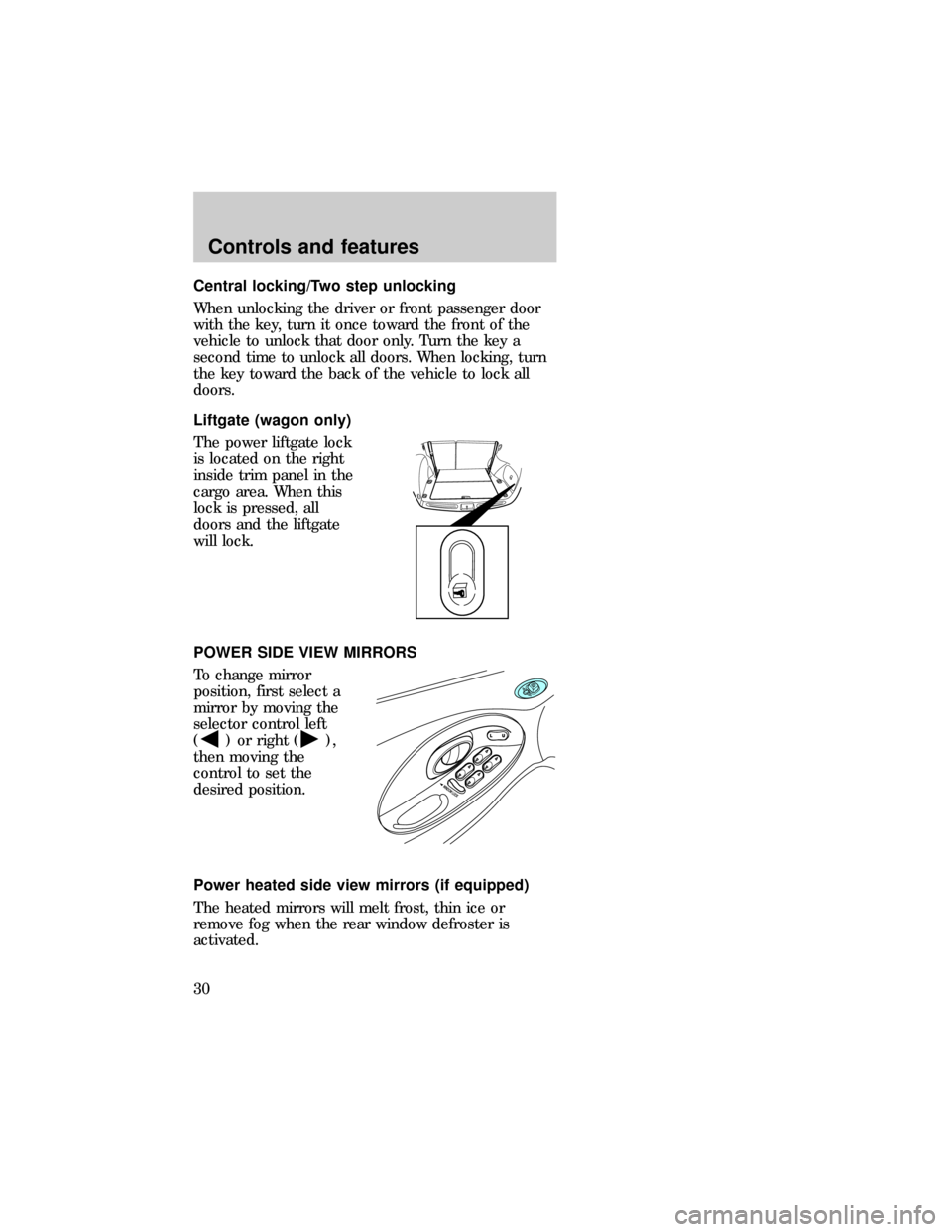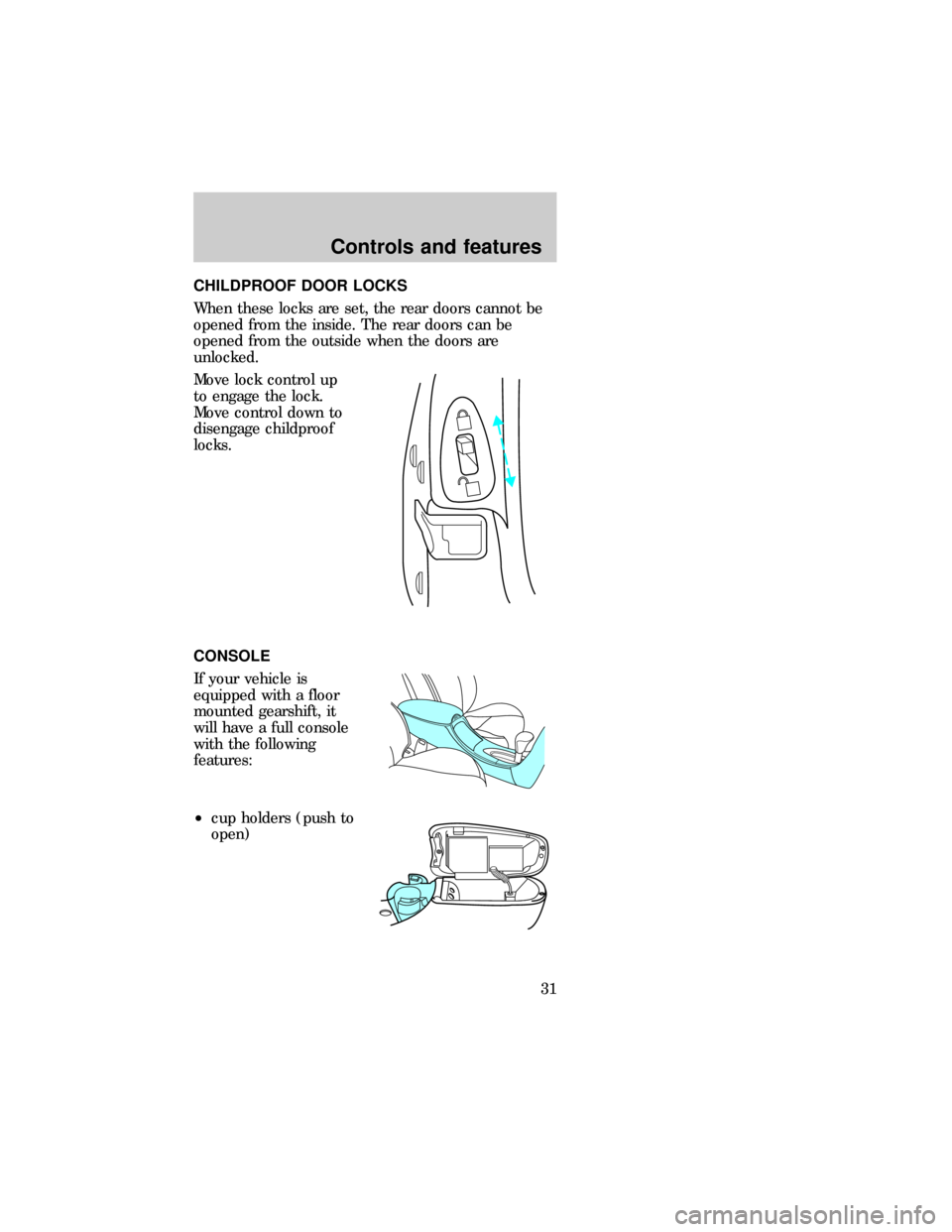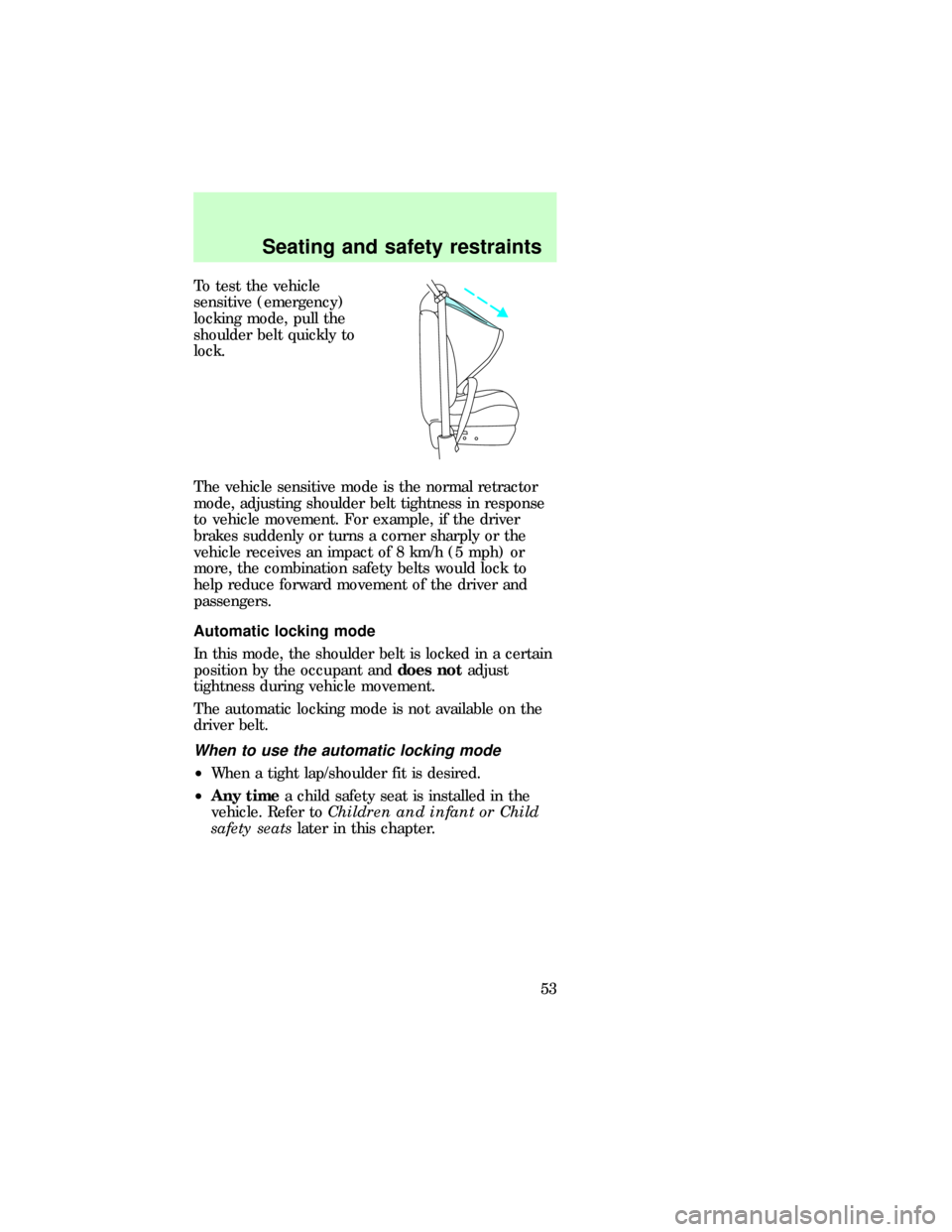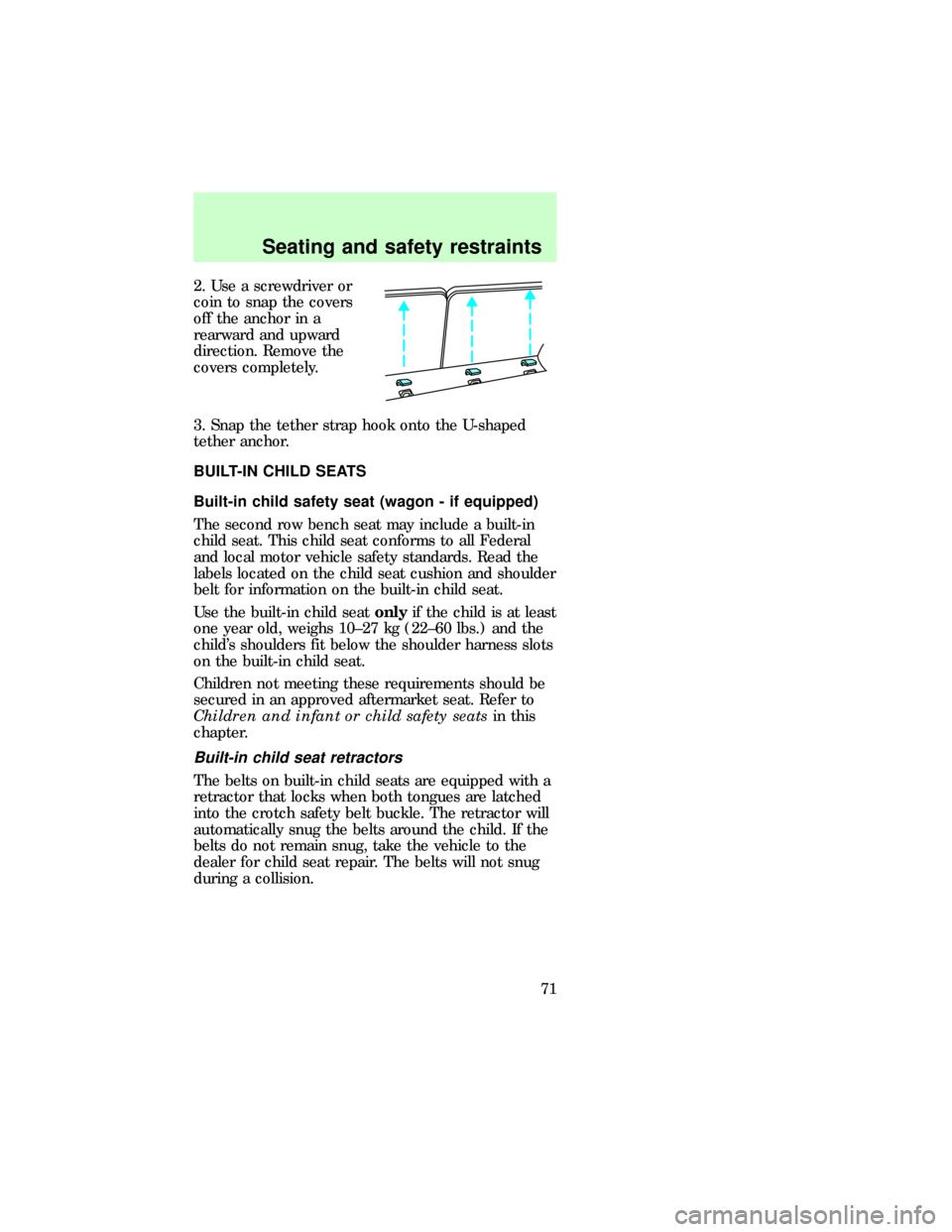child lock Mercury Sable 1997 Owner's Manuals
[x] Cancel search | Manufacturer: MERCURY, Model Year: 1997, Model line: Sable, Model: Mercury Sable 1997Pages: 167, PDF Size: 1.59 MB
Page 30 of 167

Central locking/Two step unlocking
When unlocking the driver or front passenger door
with the key, turn it once toward the front of the
vehicle to unlock that door only. Turn the key a
second time to unlock all doors. When locking, turn
the key toward the back of the vehicle to lock all
doors.
Liftgate (wagon only)
The power liftgate lock
is located on the right
inside trim panel in the
cargo area. When this
lock is pressed, all
doors and the liftgate
will lock.
POWER SIDE VIEW MIRRORS
To change mirror
position, first select a
mirror by moving the
selector control left
(
) or right (),
then moving the
control to set the
desired position.
Power heated side view mirrors (if equipped)
The heated mirrors will melt frost, thin ice or
remove fog when the rear window defroster is
activated.
dno_liftgate-locking
dno_power-mirrors
dno_mirrors
dno_child-locks
Controls and features
30
Page 31 of 167

CHILDPROOF DOOR LOCKS
When these locks are set, the rear doors cannot be
opened from the inside. The rear doors can be
opened from the outside when the doors are
unlocked.
Move lock control up
to engage the lock.
Move control down to
disengage childproof
locks.
CONSOLE
If your vehicle is
equipped with a floor
mounted gearshift, it
will have a full console
with the following
features:
²cup holders (push to
open)
dno_consoleControls and features
31
Page 52 of 167

SAFETY RESTRAINTS
Safety restraints precautions
Always drive and ride with your seatback
upright and the lap belt snug and low across
the hips.
To prevent the risk of injury, make sure
children sit where they can be properly
restrained.
It is extremely dangerous to ride in a cargo
area, inside or outside of a vehicle. In a
collision, people riding in these areas are more
likely to be seriously injured or killed. Do not allow
people to ride in any area of your vehicle that is
not equipped with seats and safety belts. Be sure
everyone in your vehicle is in a seat and using a
safety belt properly.
Combination lap and shoulder belts
1. To fasten, insert the
tongue into the slot in
the buckle.
2. To unfasten, push
the red release button
and remove the tongue
from the buckle.
The outboard safety restraints in the vehicle are
combination lap and shoulder belts. The front and
rear seat passenger outboard safety belts have two
types of locking modes described below:
dno_safety-belt-precautions
dno_manually-locking-belt
Seating and safety restraints
52
Page 53 of 167

To test the vehicle
sensitive (emergency)
locking mode, pull the
shoulder belt quickly to
lock.
The vehicle sensitive mode is the normal retractor
mode, adjusting shoulder belt tightness in response
to vehicle movement. For example, if the driver
brakes suddenly or turns a corner sharply or the
vehicle receives an impact of 8 km/h (5 mph) or
more, the combination safety belts would lock to
help reduce forward movement of the driver and
passengers.
Automatic locking mode
In this mode, the shoulder belt is locked in a certain
position by the occupant anddoes notadjust
tightness during vehicle movement.
The automatic locking mode is not available on the
driver belt.
When to use the automatic locking mode
²When a tight lap/shoulder fit is desired.
²Any timea child safety seat is installed in the
vehicle. Refer toChildren and infant or Child
safety seatslater in this chapter.
dno_when-to-use-locking-mode
dno_how-to-use-locking-mode
Seating and safety restraints
53
Page 57 of 167

Make sure you insert the tongue into the correct
buckle. If you need to lengthen the belt, turn the
tongue at a right angle to the belt and pull across
your lap until it reaches the buckle. If you need to
tighten the belt, pull the loose end of the belt
through the tongue until it is snugly across the hips.
Shorten and fasten the belt when not in use.
Safety belts for rear-facing occupants (wagon
only)
Never use child safety seats in the third seat
of a wagon.
Your vehicle is equipped with safety belts containing
an adjust tongue at the rear-facing seating positions.
When the adjust tongue of the lap/shoulder
combination seat belt is latched into the buckle, the
tongue will allow the lap portion to become shorter,
but locks the webbing in place to restrict it from
becoming longer.
Before you reach and latch a combination lap and
shoulder belt having an adjust tongue into the
buckle. you may have to lengthen the lap belt
portion of it. To lengthen the lap belt, pull some
webbing out of the shoulder belt retractor. While
holding the webbing below the tongue, grasp the
tongue so that it is parallel to the webbing and slide
the tongue upward. provide enough length so that
the tongue can reach the buckle.
To fasten the belt, pull the combination lap and
shoulder belt from the retractor so that the shoulder
belt portion of the safety belt crosses your shoulder
and chest. Be sure the belt is not twisted. If the belt
is twisted, remove the twist. Insert the tongue into
the proper buckle for your seating position until you
hear a snap and fell it latch. Make sure the tongue is
securely fastened to the buckle by pulling on the
tongue.
dno_wagon-belts
Seating and safety restraints
57
Page 66 of 167

You may wish to discuss the special needs of your
child with your pediatrician.
SAFETY SEATS FOR CHILDREN
Child and infant or child safety seats
Use a safety seat that is recommended for the size
and weight of the child. Carefully follow all of the
manufacturer's instructions with the cafety seat you
put in your vehicle. If you do not install and use the
safety seat properly, the child may be injured in a
sudden stop or collision.
When installing a child safety seat:
²Use the correct
safety belt buckle
for that seating
position.
²Make sure the
tongue is securely
fastened in the
buckle.
²Keep the buckle release button pointing up and
away from the safety seat, with the tongue
between the child seat and the release button, to
prevent accidental unbuckling.
²Place seatback in upright position.
²Put the safety belt in the automatic locking mode.
Refer toUsing the automatic locking mode.
Ford recommends the use of a child safety seat
having a top tether strap. Install the child safety seat
in a seating position which is capable of providing a
tether anchorage. For more information on top
tether straps, refer toAttaching safety seats with
tether straps.dno_child-belt
dno_child-safety-seats
Seating and safety restraints
66
Page 68 of 167

3. While holding the
shoulder and lap belt
portions together, route
the tongue through the
child seat according to
the child seat
manufacturers'
instructions. Be sure
the belt webbing is not
twisted.
4. Insert the belt
tongue into the proper
buckle for that seating
position until you hear
and feel the latch
engage. Make sure the
tongue is latched
securely by pulling on
it.
5. To put the retractor
in the automatic
locking mode, grasp
the shoulder portion of
the belt and pull
downward until all of
the belt is extracted
and a click is heard.
6. Allow the belt to retract. The belt will click as it
retracts to indicate it is in the automatic locking
mode.
7. Pull the lap belt
portion across the child
seat toward the buckle
and pull up on the
shoulder belt while
pushing down with
knee on the child seat.
PRESS
Seating and safety restraints
68
Page 69 of 167

8. Allow the safety belt
to retract to remove
any slack in the belt.
9. Before placing the
child in the seat,
forcibly tilt the seat
forward and back to
make sure the seat is
securely held in place.
10. Try to pull the belt out of the retractor to make
sure the retractor is in the automatic locking mode
(you should not be able to pull more belt out). If the
retractor is not locked, unbuckle the belt and repeat
steps two through nine.
Check to make sure the child seat is properly
secured before each use.
Attaching safety seats with tether straps
Some manufacturers make safety seats that include
a tether strap that goes over the back of the vehicle
seat and attaches to an anchoring point. Other
manufacturers offer the tether strap as an accessory.
Contact the manufacturer of your child safety seat
for information about ordering a tether strap.
Front seats
To install a tether from a child safety seat in the
front seat:
1. Buckle the lap/shoulder belt (in the seat behind
the front passenger seat in which the child safety
seat will be installed).
2. Pull all the stored belt out of the rear seat
retractor to switch the retractor to automatic locking
mode.
3. Let the retractor wind up the slack from the
lap/shoulder belt.
4. Install the child safety seat in the front seat. Refer
toInstalling child safety seats in combination lap
and shoulder belt seating positions. Hook the
dno_tether-straps
Seating and safety restraints
69
Page 70 of 167

tether strap hook around the webbing near the
center of the shoulder portion of the locked
lap/shoulder belt.
5. Tighten the tether strap.
Rear seats
If you must use a tethered safety seat on one of the
rear seats, you can anchor the strap to the
appropriate tether anchor directly behind that seat
position.
Tether anchorage hardware
Attachment holes (at each rear outboard seating
position) have been provided in your vehicle to
attach anchor hardware, if required. Tether
anchorage hardware kits (part number 613D74)
including instructions, may be obtained at no charge
from any Ford or Lincoln-Mercury dealer. All
vehicles built for sale in Canada include a tether
anchor hardware kit.
Be sure to follow the child safety seat
manufacturer's instructions.
Tighten the anchor according to
specifications. Otherwise, the safety seat
may not be properly secured and the child may be
injured in a sudden stop or collision.
If you have a station wagon, tether anchors are
already installed for each of the second row seating
positions.
1. Behind the second
seat, find the plastic
snap-on covers for the
floor anchors.
dno_hardware
Seating and safety restraints
70
Page 71 of 167

2. Use a screwdriver or
coin to snap the covers
off the anchor in a
rearward and upward
direction. Remove the
covers completely.
3. Snap the tether strap hook onto the U-shaped
tether anchor.
BUILT-IN CHILD SEATS
Built-in child safety seat (wagon - if equipped)
The second row bench seat may include a built-in
child seat. This child seat conforms to all Federal
and local motor vehicle safety standards. Read the
labels located on the child seat cushion and shoulder
belt for information on the built-in child seat.
Use the built-in child seatonlyif the child is at least
one year old, weighs 10±27 kg (22±60 lbs.) and the
child's shoulders fit below the shoulder harness slots
on the built-in child seat.
Children not meeting these requirements should be
secured in an approved aftermarket seat. Refer to
Children and infant or child safety seatsin this
chapter.
Built-in child seat retractors
The belts on built-in child seats are equipped with a
retractor that locks when both tongues are latched
into the crotch safety belt buckle. The retractor will
automatically snug the belts around the child. If the
belts do not remain snug, take the vehicle to the
dealer for child seat repair. The belts will not snug
during a collision.
dno_built-in
dno_second-row-seat
Seating and safety restraints
71